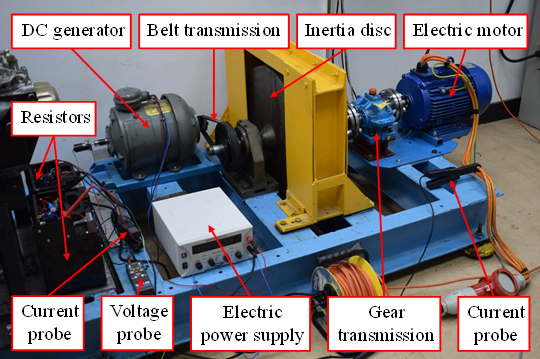Analysis of the strategies for managing extended-range electric vehicle powertrain in the urban driving cycle
DOI:
https://doi.org/10.20998/2074-272X.2022.1.10Keywords:
extended-range electric vehicle, alternative fuel, liquefied petroleum gas, driving cycleAbstract
Introduction. An Extended-Range Electric Vehicle (EREV) is a type of electric vehicle that uses an additional internal combustion engine (ICE) to charge the battery in order to provide the vehicle with a greater range than in electric only mode. Purpose. Analysis and comparison of the performance of EREV powertrain managed according to three control strategies: pure electric mode, hybrid mode with ICE constantly working, and hybrid mode with ICE working only at high power demand. Methods. The tests were carried out using a laboratory test stand that represented the structure of EREV powertrain. Liquefied petroleum gas was used as a fuel to supply the ICE. The test conditions were defined by a special driving cycle simulating urban driving. Results. Time series plots of selected parameters of electric motor, electrochemical battery pack, range extender generator and active load system. Practical value. Among the considered control strategies of EREV powertrain, the energy balance of the electrochemical battery is negative for a purely electric mode, significantly positive for continuous range extenders (REXs) operation mode and moderately positive for the mode with REX activation only in dynamic states.
References
Dell R.M., Moseley P.T., Rand D.A.J. Progressive Electrification of Road Vehicles, in Towards Sustainable Road Transport, Eds. Cambridge, Academic Press, 2014, pp. 157-192. doi: https://doi.org/10.1016/B978-0-12-404616-0.00005-0.
Gis W., Waśkiewicz J., Gis M. Projections of future use of electric cars. Journal of KONES Powertrain and Transport, 2015, vol. 22, no. 2, pp. 55-62. doi: https://doi.org/10.5604/12314005.1165395.
Singh K.V., Bansal H.O., Singh D. A comprehensive review on hybrid electric vehicles: architectures and components. Journal of Modern Transportation, 2019, vol. 27, no. 2, pp. 77-107. doi: https://doi.org/10.1007/s40534-019-0184-3.
Chmielewski A., Szulim P., Gregorczyk M., Gumiński R., Mydłowski T., Mączak J. Model of an electric vehicle powered by a PV cell – A case study. 2017 22nd International Conference on Methods and Models in Automation and Robotics (MMAR), 2017, pp. 1009-1014. doi: https://doi.org/10.1109/mmar.2017.8046968.
Orecchini F., Santiangeli A. Automakers’ Powertrain Options for Hybrid and Electric Vehicles, in Electric and Hybrid Vehicles, Pistoia G. Ed., Elsevier, 2010, pp. 579-636. doi: https://doi.org/10.1016/B978-0-444-53565-8.00022-1.
Bradley T.H., Frank A.A. Design, demonstrations and sustainability impact assessments for plug-in hybrid electric vehicles. Renewable and Sustainable Energy Reviews, 2007, vol. 13, no. 1, pp. 115-128. doi: https://doi.org/10.1016/j.rser.2007.05.003.
Mansour C., Clodic D. Optimized energy management control for the Toyota Hybrid System using dynamic programming on a predicted route with short computation time. International Journal of Automotive Technology, 2012, vol. 13, no. 2, pp. 309-324. doi: https://doi.org/10.1007/s12239-012-0029-0.
Naeem H.M.Y., Bhatti A.I., Butt Y.A., Ahmed Q. Velocity Profile optimization of an Electric Vehicle (EV) with Battery Constraint Using Pontryagin’s Minimum Principle (PMP). 2019 IEEE Conference on Control Technology and Applications (CCTA), 2019, pp. 750-755. doi: https://doi.org/10.1109/CCTA.2019.8920609.
Lee W., Jeoung H., Park D., Kim N. An Adaptive Concept of PMP-Based Control for Saving Operating Costs of Extended-Range Electric Vehicles. IEEE Transactions on Vehicular Technology, 2019, vol. 68, no. 12, pp. 11505-11512. doi: https://doi.org/10.1109/TVT.2019.2942383.
Du J., Chen J., Song Z., Gao M., Ouyang M. Design method of a power management strategy for variable battery capacities range-extended electric vehicles to improve energy efficiency and cost-effectiveness. Energy, 2017, vol. 121, pp. 32-42. doi: https://doi.org/10.1016/j.energy.2016.12.120.
Pozzato G., Formentin S., Panzani G., Savaresi S.M. Least costly energy management for extended-range electric vehicles: An economic optimization framework. European Journal of Control, 2020, vol. 56, pp. 218-230. doi: https://doi.org/10.1016/j.ejcon.2020.01.001.
Chen Y., Zhang Y., Wei C., Li G., Li C. Optimization of extended range electric vehicle energy management strategy via driving cycle identification. IOP Conference Series: Materials Science and Engineering, 2020, vol. 793, no. 1, p. 012040. doi: https://doi.org/10.1088/1757-899x/793/1/012040.
Yu Y., Jiang J., Min Z., Wang P., Shen W. Research on Energy Management Strategies of Extended-Range Electric Vehicles Based on Driving Characteristics. World Electric Vehicle Journal, 2020, vol. 11, no. 3, p. 54. doi: https://doi.org/10.3390/wevj11030054.
Lasocki J., Kopczyński A., Krawczyk P., Roszczyk P. Empirical Study on the Efficiency of an LPG-Supplied Range Extender for Electric Vehicles. Energies, 2019, vol. 12, no. 18, p. 3528. doi: https://doi.org/10.3390/en12183528.
Kopczyński A., Krawczyk P., Lasocki J. Parameters selection of extended-range electric vehicle supplied with alternative fuel. E3S Web of Conferences, 2018, vol. 44, p. 00073. doi: https://doi.org/10.1051/e3sconf/20184400073.
Kopczyński A., Piórkowski P., Roszczyk P. Parameters selection of extended-range electric vehicle powered from supercapacitor pack based on laboratory and simulation tests. IOP Conference Series: Materials Science and Engineering, 2018, vol. 421, p. 022016. doi: https://doi.org/10.1088/1757-899x/421/2/022016.

Downloads
Published
How to Cite
Issue
Section
License
Copyright (c) 2022 J. Lasocki, P. Krawczyk, A. Kopczyński, P. Roszczyk, A. Hajduga

This work is licensed under a Creative Commons Attribution-NonCommercial 4.0 International License.
Authors who publish with this journal agree to the following terms:
1. Authors retain copyright and grant the journal right of first publication with the work simultaneously licensed under a Creative Commons Attribution License that allows others to share the work with an acknowledgement of the work's authorship and initial publication in this journal.
2. Authors are able to enter into separate, additional contractual arrangements for the non-exclusive distribution of the journal's published version of the work (e.g., post it to an institutional repository or publish it in a book), with an acknowledgement of its initial publication in this journal.
3. Authors are permitted and encouraged to post their work online (e.g., in institutional repositories or on their website) prior to and during the submission process, as it can lead to productive exchanges, as well as earlier and greater citation of published work.




